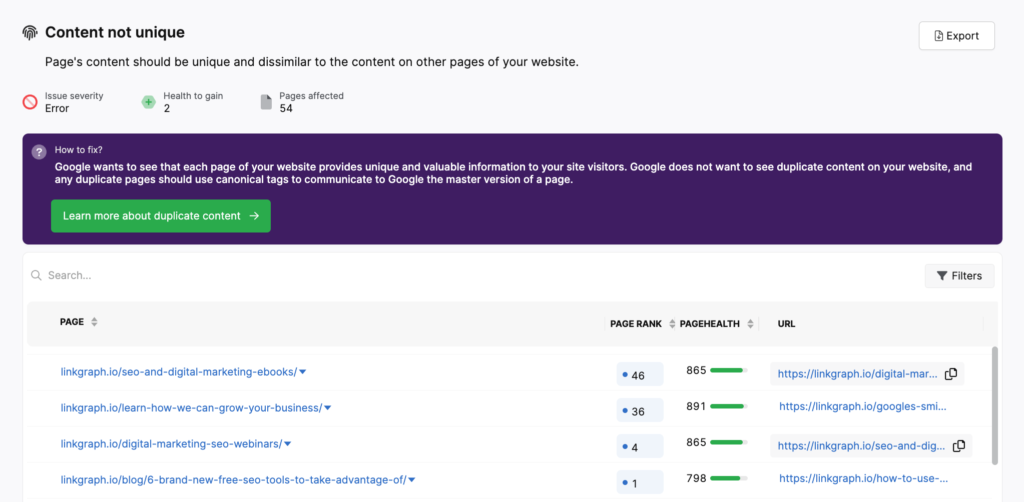What Is Duplicate Content in SEO and How to Fix It
Duplicate content is a problem for any website that wants to rank in search engines because it can complicate the user experience and confuses search engines. But […]
Duplicate content is a problem for any website that wants to rank in search engines because it can complicate the user experience and confuses search engines.
But most of the time, duplicate content is not intentional and is caused by technical issues or automatically generated pages.
Resolving duplicate content can be an easy process, and this guide will cover all of the causes of duplicate content and how to fix it before it negatively impacts your search engine rankings.
What is Duplicate Content in SEO?
Duplicate content is content that appears on the same website in more than one place. It can also refer to the same content appearing on multiple websites. This content can take the form of identical or near-identical content, and it is ultimately detrimental to SEO visibility.
Why is Similar Content a Problem?
Google wants webmasters to provide valuable and unique content to users. If your website has lots of similar pages, it doesn’t signal a website that provides a good user experience.
The primary technical problem with duplicate content is that it causes search engines to have a more difficult time determining which version of the content should be indexed and displayed in search results.
When Google faces this problem, it usually promotes both versions of the content less often.
Does Duplicate Content Result in a Penalty?
You may have read about a possible duplicate content penalty, but Google will not penalize websites that make an honest mistake. Most often, webmasters do not intentionally publish duplicate content on their websites or are unaware that the same content is available on different URLs.
But if a website is consistently copying content from other websites and publishing it as its own, that’s a different issue. Google will penalize and potentially de-index those domains that are copying content from other websites.
You can read more about what Google says about duplicate content here.
What Causes Duplicate Content?
There are a few possible explanations for why your website has duplicate content or duplicate pages.
- Duplicate content can be created inadvertently, such as when different versions of a URL point to the same page
- When the content is served with subdomains that are not the canonical domain, such as https://www.website.com/ versus https://website.com/
- When content is syndicated across multiple websites
- Websites that are improperly set up can often cause duplicate content
- Duplicate pages that do not include the proper canonical tags to tell Google that they are copies of a master version of the page
How Do I Avoid Duplicate Content?
In order to avoid duplicate content in SEO, it’s vital to ensure that all web pages on a website have unique and original content.
Additionally, it’s worth taking the time to make sure that the same content is not accessible from multiple URLs. It’s also necessary to be aware of syndicated content and to implement measures to avoid duplicate content issues.
But the simplest way is to use a site auditing tool. When duplicate content is found on your website, it will be flagged in the Search Atlas site auditor.
Thankfully, duplicate content is a simple fix, and there are a few options for preventing repeated duplicate content from appearing on your website.
How to Fix Duplicate Content in SEO
If you have a web page that is flagged in the Search Atlas site auditor for duplicate content issues, there are a few different options for resolving it.
Update the Content on the Page
If the content or copy of the page is too similar to other pages, Google will not understand which page to promote in the SERPs for related keywords. In general, you want the different pages of your website to rank for different keyword clusters, and reoptimizing the page for a different set of keywords will help search engine crawlers more easily understand the content as unique.
Use a 301 Redirect
The first way is to use 301 redirects. A 301 redirect is a permanent redirect from one URL to another. This redirect lets search engines know that the original page has been permanently moved to the new page. This strategy prevents search engines from indexing duplicate pages.
Add Canonical Tags to Similar or Duplicate Pages
If your website has lots of product pages that are similar, you should get comfortable using canonical tags to communicate to Google which page is the master version of the content and should be indexed. This method helps search engines identify which version of the page should be ranked.
Add a noindex tag
The third way is to use the noindex tag. The noindex tag tells search engines to not index the page. This technique prevents them from indexing the duplicate page.
Consider a Content Delivery Network
Finally, you can use a content delivery network (CDN). A CDN is a network of servers that delivers web content to users based on their location. This network helps ensure that users are seeing the content from the original page and not a duplicate page. If you have different regional versions of a web page, a CDN may be the most viable solution.
Conclusion
Ultimately, fixing duplicate content in SEO is critical for any SEO strategy. To ensure that a website remains SEO-friendly, it’s necessary to identify and address duplicate content issues before they become a problem. Make sure you use the site auditor in your dashboard to identify and resolve duplicate content when it appears.

















































































